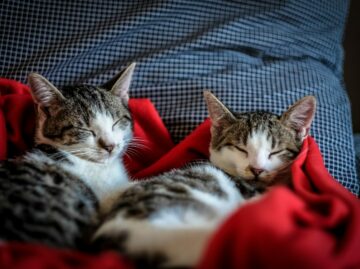Reptiles are a great choice for beginners or those without experience in taking care of pets. Most reptile pets are self-sufficient, require little or no maintenance, and are quite resilient. They are also considerably less expensive to care for compared to dogs, cats, or even caged pets like hamsters and guinea pigs. However, before you start choosing one, note first that there are 4 classes of reptiles – the Squamates (lizards and snakes), the Turtles, the Crocodilians, and the Rhyncocephalians (Tuataras). Owning species from the last 2 classes is not just going to be difficult, but will most likely be illegal, so just stick with lizards, snakes, or turtles. If you would like to start on reptile-keeping, then here are a few fun facts about popular reptiles that might help you.
Leopard gecko
Photo by cubialpha
- They eat their old skin, so you don’t need to worry about cleaning up after they molt.
- They don’t have sticky pads on their feet so they are not as good as other lizards when it comes to climbing. This lowers the chance of them escaping, so it might be a good thing, especially for an inexperienced handler.
- They make a lot of sounds. Some can even “bark”.
- They can live up to 20 years old, given the right conditions, and sufficient resources. You can watch a detailed guide on how to set up the ideal enclosure for them online.
- They have a gentle disposition, making them perfect for beginner handlers.
Crested gecko
Photo by vujicivana
- They are often called eyelash geckos because of the frills above their eyes. Ironically though, they don’t have eyelashes or eyelids. Instead, these lizards have a transparent scale to protect their eyes.
- Crested geckos lick their eyes often to keep them clean and free from dirt and debris.
- They also come in a variety of colors and patterns. According to researchers and gecko experts, the crested gecko’s patterns are unique to each individual. No two look the same. These colors can also become more vibrant or duller depending on the gecko’s current state.
- They make different sounds, even chirping noises.
- The crested gecko hatchlings’ first meal will be the skin they molt out of. They will only eat other stuff after they’ve consumed their first skin.
Bearded dragon
Photo by Lily
- This lizard scores high on the coolness factor because of its looks. The spikes on their chin (where they got their name from), make these average-sized lizards look like miniature dragons.
- They are omnivorous – they’ll eat plants and meat. And even if you give them meat, they don’t need to be fed with live prey.
- They are surprisingly sociable creatures. They will happily live with other bearded dragons in groups. Some even enjoy nuzzling with their human friends (after earning their trust).
- They have excellent eyesight and hearing. You can use this to get their trust.
- Like chameleons, bearded dragons change colors too. These changes often indicate moods or changes of states – like when alarmed, relaxed, or sometimes to call the attention of possible mates.
Chameleon
Photo by Nandhu Kumar
- Their name (in Latin) means “ground lions” or lions on the ground, most likely because their head crests look like a mane and also because these lizards can be quite voracious eaters.
- They are specialized for tree-living. Their toes are fused into 2 or 3 opposite sets, allowing them to grip branches and leaves. A lot of chameleon species also have prehensile tails that curl around branches (for balance and support).
- They change colors, but not always for camouflage. Sometimes, these changes are triggered by poor health, pregnancy, temperature changes, and behaviors. To find out how they change colors though, you can watch the full explanation here.
- Because they can independently rotate their eyes, they can have almost full 360-degree vision.
- They use their tongue for catching prey. These tongues can be twice as long as their bodies and shoot out to catch an insect in less than a tenth of a second.
Corn snake
Photo by sipa
- Although they can sometimes be found near corn farms, this is not where they got their name from. It’s the fact that their coloration resembles that of Indian corn (with red and black kernels).
- They are non-venomous so they kill their prey (usually rodents) by constriction. Some farmers now use them to control the mice population since they’re good mouse hunters and pose no threat to humans.
- They can live for as long as 20 years.
- They prefer living alone.
- They are one of the most popular snake choices for pets.
Ball python
Photo by Die_Sonja
- Their name comes from their defensive behavior of curling into a ball to appear small and to protect their heads (their weakest spot) from danger.
- They like grass and water. Be sure to have both if you’re planning on keeping one.
- Their markings or patterns are unique to each individual. No two are the same.
- They are non-venomous but they have a lot of small teeth, so it can still hurt to get bitten by this snake.
- When socialized properly, they can be friendly and tolerate handling well.
Red Eared Sliders
Photo by zoosnow
- Their name comes from the red streak that is found on the side of their heads, starting from the side of their eyes and reaching to their ears.
- They like slow-moving water and prefer to be in groups.
- They have great vision but poor hearing. Instead of listening to sounds, they would rather tune in to vibrations in the water.
- They start as omnivores, feeding on plants and small animals (insects, snails, small fish, and even small birds), then become herbivores when they grow older.
- They need to sunbathe daily for a minimum period.
Eastern box turtle
Photo by JamesDeMers
- They can live a long life, averaging at least 40 years of age.
- Females can store sperm for a long time after mating. They can even produce fertilized eggs 4 years after the sperm is stored.
- They will eat anything – insects, slugs, fish, grass, berries, and even birds.
- They are not good swimmers. They can drown in water that is too deep.
- Their shells grow throughout their lives and will regenerate damaged areas.
Frequently Asked Questions:
How often do reptile pets shed their skin or molt?
The average ages and periods between shedding or molting vary between reptile species (especially in snakes and lizards). Generally speaking though, shedding is related to growth, so if your pet is in a healthy condition and at a good age, then expect frequent shedding. However, if your pet is not molting or shedding skin, it may be due to slowed growth or possibly even a health issue. Healthy and young snakes can shed their skins in just 2-5 months.
Is temperature regulation important to pet reptiles?
Yes. If you’re living in areas where temperatures can drop low, you may want to invest in a good temperature regulator for your pet enclosures. Since reptiles are generally cold-blooded, they rely heavily on external heat sources to maintain proper body temperatures. Failure to provide enough warmth for your reptile pets can lead to them undergoing some type of hibernation (or any similar state of inactivity) and even death. This becomes doubly important if your pets are already laying eggs because reptile gender development is often dictated by specific temperatures.
How much do you need to start reptile-keeping?
Reptiles are generally more affordable compared to other typical household pets. You can walk out of a pet store with your very first gecko or turtle, or maybe even a ball python with just 50-100 dollars. However, if you’re just starting, you should also include an enclosure or a terrarium setup (including the substrate, water hole, and even some foliage), as well as your initial batch of pet food at the initial cost. Your total should range anywhere from a few hundred to a few thousand dollars depending on the size of the enclosure, the setup, and the price of the reptile itself.
The good news is, after this initial cost, you won’t be spending on anything else other than your succeeding batches of pet food.







